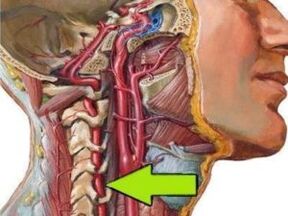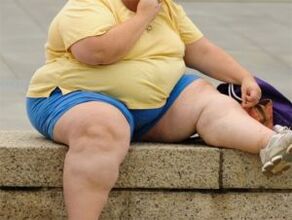Among all pathological processes that influence the spine in its different parts, cervical osteochondrosis is considered one of the most common and painful.This disease leads to many complications, mainly because it influences the spinal cord and also negatively influences the functioning of the brain.

What is cervical osteochondrosis?
The words of cervical osteochondrosis in medical practice mean a acquired progressive disease that affects the specific spine.This pathological process is characterized by degenerative-dystrophic processes in the tissues of the intervertebral discs, which are shock absorbers for the cervical vertebrae.Degenerative-dystrophic changes in the intervertebral discs are due to the fact that they are deleted and deformed.As a result, the distance between the vertebrae is reduced and as a result the following consequences occur:
- Narrowing of the spine canal in certain areas of the spine.
- Transfer of the vertebral arteries - large blood vessels that supply blood to the brain.For this reason, the supply of the brain is deteriorated and the blood circulation in the neck mark is disturbed.
- Intervertebral discs can be deformed and flattened.This means that individual sections of the spinal cord and nerves are squeezed.The nerve roots are pressed more often.
All of these problems not only threaten a violation of the blood circulation of the brain, painful sensations in the neck, headache, etc. The development of the osteochondrosis of the cervical region is dangerous with problems of a neurological nature, deterioration in the central nervous system, damage to the brain tissue.After the international classification of diseases, several separate codes osteochondrosis of the cervix region were assigned.The disease code for ICB 10 depends on the age of the disease: the disease has been diagnosed:

- M02 - dystrophy of intervertebral discs in adolescence.
- M42.12 is a dystrophic process in the neck in adults.
Many factors depend on the age of the patient and the degree of development of the pathological process, for example consequences, complications, symptoms and of course the treatment principles.
Causes
Knowledge of the causes of the development of the osteochondrosis of the cervix region can play a crucial role in the diagnostic process and determine the principles of combating the disease.Before you list the reasons, however, it is worth that doctors distinguish two factors that lead to the development of this pathological process:
- Pathological - The destruction of the intervertebral discs and other vertebrates with the participation of nearby tissues, blood vessels and nerve rays on the pathological process under the influence of adverse external factors.The more difficult these factors and other pathologies are, the faster the disease develops.
- Physiologically - based on the development of pathology, mainly age -related changes.We talk about the natural aging of cartilaginous tissues in the spine, in salts, etc.
If we list more specific causes of cervical osteochondrosis, they are as follows:
- Violation of metabolic processes in the body and certain phases of obesity.
- Hypodynamics is a phenomenon characterized by a restriction of mobility.It is not just about injuries or illnesses, but can also include a seated lifestyle and sitting work.
- Pathologies of the cardiovascular system, which contribute to the impairment of blood circulation in the brain, pressure changes and other things.
- Wrong attitude, these are different forms of scoliosis, rheumatism and even flat feet.
- Injection of the cervical spine.In this case we talk about sprains, strikes and bruises.Studies of other spine in the development of cervical osteochondrosis can affect the development of cervical osteochondrosis.
- Excessively great physical exertion in the cervix region, which is caused by intensive sports or severe physical difficult, depending on human activity.
- A sitting lifestyle is also dangerous with a constant voltage of the cervical spine and the entire spine if you sit wrong or on unpleasant furniture.
- A hernia of the cervical spine and various related diseases.
- Forced long -term attitude of the head in an unpleasant or unnatural position.In this case, not only muscle over pressure occurs, but also the spine, but also in the cervix region.
- The doctors consider constant stress and nervous overvoltage as a very common cause.
- One of the reasons is also congenital anomalies in the structure of the spine.

What is the danger to health?
As already mentioned, there are not only the spinal cord and various nerve branches in the cervical spine, but also the spine arteries that provide the occipital part of the brain, the cerebellum and the medullavian brain.With the development of cervical osteochondrosis, nearby tissues are inflamed.In addition, the development of pathology threatens the nerve roots and the transmission of blood vessels, the consequences are as follows:
- Osteochondrosis is accompanied by deformations of the spine, from which the cerebrospinal canal is narrowed in certain areas.This can cause the spinal cord and the nervous branches to be pressed, which promises severe neurological problems.In severe cases, a person feels pain, even if there is the possibility of loss of control via individual parts of the body (mainly in the hand or face).
- As already mentioned, squeezing the vessels of the neck is accompanied by a violation of the bloodstream in the Occipital area of the brain.At the same time, the brain stops obtaining oxygen and nutrients in the required quantities that begins to lack oxygen.In the case of circulatory disorders, there is a real risk of ischemic stroke and various neurological pathologies.
Syndromes
The main syndromes are:
- Wirk.
- Wirting artery.
- Koreshka.
- Heart.
It is important to know that each of these symptoms of painful sensations of different nature and many unfavorable clinical signs are accompanied.One person can feel dizziness, a sound appears in his ears and much more.

Wirbel syndrome
It speaks of the direct connection of the osteochondrosis of the cervix region with bones and cartilaginous tissue.The symptoms of this type of pathology are also associated with the lesion of the tissue mentioned:
- The neck movements are partially or completely limited.
- The movements of the head are accompanied by pain in the neck.
- X -Ray shows morphological changes in the tissue (intervertebral and in the body of the vertebrae).
It is worth noting that the vertebra syndrome is always accompanied by these three clinical signs.If at least 1 of them are missing, the diagnosis is completely different.
Rook syndrome
It occurs when the roots of the spinal cord are damaged.At the same time, the nervous conductivity is disturbed, a person can feel pain or lose the sensitivity of individual parts of the body or even suffer from paralysis.Depending on which of the 8 radicular couples gives a disorder of conductivity, such symptoms are differentiated:
- 1 pair - numbness or pain in the back of the head;
- 3 pairs - violation of the chewing reflex, the deafness of the tongue and unpleasant sensations behind the ears;
- 4 pairs - pain in the collarbone, violation of the swallow reflex;
- 5 pairs - violations of the shoulder girdle accompanied by the problem of the hand movement;
- 6 pairs - the patient begins pain and numbness in the forearm and shoulder leaves;
- 7 pairs - hands and fingers go deaf (often index and middle);
- 8 pairs - similar problems that are similar to the past object, but deafness can be felt in the ring finger and in the little finger.
Cardial syndrome
Despite the fact that the pathological process is still located in the cervical spine, the syndrome has all the signs of cardiac pathologies.The clinical picture is as follows:
- Quick pulse.
- Pain in the region of the chest.
- Breath, weakness, lethargy, performance acceptance.
Signs and symptoms of a neck osteochondrosis
For the timely search for a doctor, it is necessary to clearly understand the signs of cervical osteochondrosis.In some cases, you can find help in the early stages of the disease if it is easier to treat.In general, the symptoms of osteochondrosis of the cervical spine are as follows:

- Pain in osteochondrosis is always available, only intensity and frequency differ.It is pain that is the first clinical sign.Their intensity depends on the progress of the disease, in nature they are stupid or press.Painful sensations are mainly in the neck of the background area, but can also radiate into the temporal area, the shoulder girdle and hands.
- In most cases there are manifestations of the lesion of the vestibular apparatus.We speak of frequent causes without dizziness, nausea, impairment of the coordination of movements, uneven gait, loss of space.
- One of the most common clinical signs is the rigidity of the neck muscles and the stiffness of the movements.It is difficult for a person to rotate, lower and throw your head away, movements react with pain attacks.
- Many patients notice the feeling that goose bumps “run through the scalp” or that a characteristic tingling can be felt.
- There is muscle weakness and deafness in the area of the hands.
- There are often psychological manifestations that are expressed in depression, drowsiness, a strong change in the mood, temperament or irritability.
- Due to the impaired blood circulation and the damage to the brain tissue, dizziness and the noise in the ears appear, similar to rustling, pulsation.
- Most patients notice visual impairments and pain in their eyeballs, especially if they try to mow their eyes to the left, right, top or below.
Sometimes it is possible to determine the degree of development of the pathological process by symptoms.However, this is still not sufficient for a complete diagnosis and a number of diagnostic measures are required.
Diagnostic methods
The diagnosis of an osteochondrosis of the cervical spine is required to determine the localization and progress of the disease.Such diagnostic methods are required for full diagnosis:
- X -Ray - The primary method with which you can determine the degree and the location of the deformation of the spine.
- You can use computer tomography for a more precise diagnosis of pathological changes in the vertebrae and intervertebral discs.
- MRI (Magnnetoresonance Imaging) - it enables the wheels and vertebrae to examine the presence of hernia, protrusions and the scale of lesions of the rest.
- Doplerography - At the same time, the investigation is the opportunity to find a place to press the artery and to evaluate the degree of circulatory disorders.
Treatment methods
The treatment of neck osteochondrosis always implies an integrated approach.The treatment principles depend on the mass of the factors, such as the age of the patient, the stage of development of the disease, the brightness of the clinical image, etc. However, in this situation you cannot get by without a doctor, and above all you can consult a therapist who then leads you to a vertebrologist.As for the integrated approach, osteochondrosis of cervical osteochondrosis is treated using drug therapy, physiotherapy, massages, training therapy and other methods that should be discussed more detail.
Drug treatment
The basis for the treatment of cervical osteochondrosis is drug therapy that includes the use of tablets, medication and medication of such groups:
- Anesthetics - analgesics and anti -spas modos.The former blunt nervous centers and thus stop painful sensations.The latter enable them to relieve the neck muscles, to establish blood flow and to suppress pain.
- NSAIDS not -steroid anti -inflammatory drugs are required to reduce the inflammatory process.Most of them also eliminate pain.These drugs are often used in the form of gels, ointments that are rubbed into the affected area.
- Musorelaxants are another way to remove muscle spasms in the cervix region.
- Chondroprotectors are mandatory in certain stages of the CHOP osteochondrosis because they contribute to the restoration of bone tissue.
- B -Vitamine - normalize the metabolic processes of nerve tissues, improve the conductivity of nerve impulses and contribute to the work of the central nervous system.
Remember that the treatment should only be carried out under the supervision of a doctor who is responsible for the appointment of each drug and determines the duration of its recording and dosage.
Physiotherapy
The treatment of the neck osteochondrosis will be many times more effective with some physiotherapy techniques:

- Electrophoresis.
- Laser therapy.
- Ultrasonic.
- Massage.
Massage therapy is necessarily carried out by an experienced health personnel.The treatment takes place by at least 10 sessions.Massages of the cervix region help to normalize the blood circulation, elasticity, muscle tone, relieve pain, etc.
Manual therapy
Manual therapy is based on the principle of restoring motor functions and mobility between the vertebrae.First of all, the manipulations are in a light, relaxing massage, then the doctor finds more and more strength, affects the vertebrae of the pressure and the neck change.
The use of KuznetSov applicators is one of the therapy methods for diseases of the spine, including osteochondrosis.The effect of the adaptation to the cervical region normalizes the metabolic processes, relieves pain, increases the muscle tone, improves blood circulation, increases the conductivity of nerve tissue, etc. to prevent osteochondrosis.It is useful to swim on the horizontal bar for 2 to 3 minutes every day and capture the horizontal bar.

























































































